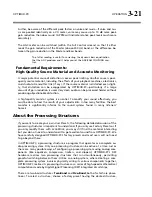
3-12
OPERATION
ORBAN MODEL 1101
Input Conditioning:
Before the stereo enhancer, a sample rate converter converts
the sample rate at the digital input to OPTIMOD-PC’s internal 48 kHz rate. This 48
kHz rate accommodates a 20 kHz audio bandwidth with a comfortably wide 4 kHz
transition band for the anti-aliasing filter. We are aware of no bias-controlled dou-
ble-blind studies that have ever demonstrated that sample rates higher than 48 kHz
are audibly superior to 48 kHz (or even that there is any audible difference at all).
Moreover, the noise and distortion produced by a given digital filter at 48 kHz is
about 6 dB lower than the N&D produced by a filter having the same frequency re-
sponse but operating at 96 kHz. OPTIMOD-PC uses many digital filters, both in its
equalizer section and for the crossovers in the multiband compressor. Hence, we be-
lieve that 48 kHz is the ideal rate for OPTIMOD-PC’s audio processing.
A sweepable 18 dB/octave highpass filter and a defeatable phase rotator (located
after the stereo enhancer) complete the input-conditioning block. The highpass fil-
ter is useful for production applications where it is necessary to remove low fre-
quency rumble from a recording. The phase rotator makes speech more symmetrical,
reducing its peak-to-average ratio by as much as 6 dB without adding nonlinear dis-
tortion. Hence, phase rotation can be very useful for loudness processing of speech.
Gating circuitry detects “mono” material with slight channel or phase imbalances
and suppresses enhancement so this built-in imbalance is not exaggerated. It also
allows you to set a “width limit” to prevent over-enhancement of material with sig-
nificant stereo content, and will always limit the ratio of L–R / L+R to unity or less.
Two-Band Gated AGC:
The AGC is a two-band device, using Orban’s patented
“master / bass” band coupling. It has an additional important feature: target-zone
gating. If the input program material’s level falls within a user-settable window (typ-
ically 3dB), then the release time slows to a user-determined level. It can be slow
enough (0.5 dB/second) to effectively freeze the operation of the AGC. This prevents
the AGC from applying additional, audible gain control to material that is already
well controlled. It also lets you run the AGC with fast release times without adding
excessive density to material that is already dense.
The AGC contains a compression ratio control that allows you to vary to ratio be-
tween 2:1 and essentially
∞
:1. Lower ratios can make gain riding subtler on critical
formats like classical and jazz.
The AGC has its own silence-gating detector whose threshold can be set independ-
ently of the silence gating applied to the multiband compressor.
Equalization:
OPTIMOD-PC has a steep-slope bass shelving equalizer and three
bands of fully parametric bell-shaped EQ.
You can set the slope of the bass shelving EQ to 6, 12, or 18 dB/octave, adjust the
shelving frequency and set the amount of equalization.
OPTIMOD-PC’s bass, midrange, and high frequency parametric equalizers have
curves that were modeled on the curves of Orban’s classic analog parametrics (like
the 622B), using a sophisticated, proprietary optimization program. The curves are
matched to better than 0.15dB. This means that their sound is very close to the
Содержание Optimod-PC 1101
Страница 4: ......
Страница 14: ......
Страница 121: ...OPTIMOD PC OPERATION 3 1 Section 3 Operation Figure 3 1 The OPTIMOD PC Control Application...
Страница 192: ...3 72 OPERATION ORBAN MODEL 1101...
Страница 204: ......
Страница 210: ......
Страница 212: ...5 2 UNINSTALLATION ORBAN MODEL 1101...
Страница 236: ......















































